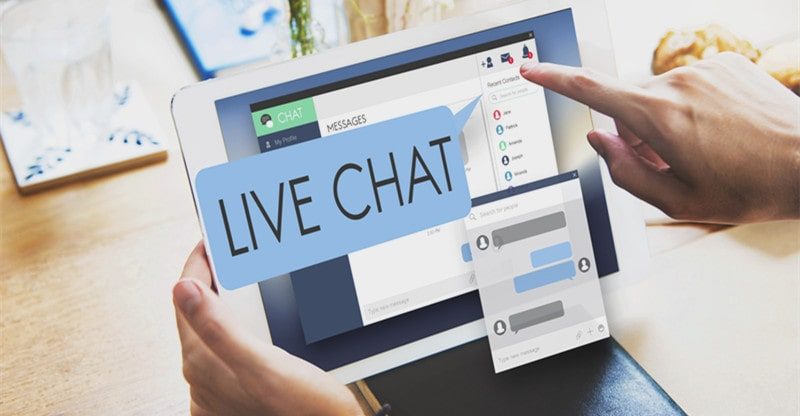Pros And Cons Of Having Live Chat In Your Retail App
Look up for a minute. What do you see?
I bet people around you are engrossed in their phones, texting to friends, family, colleagues, or even businesses.
According to Pew Research Center, 97% of smartphone owners text regularly. Life without messaging seems almost unimaginable. How else could you multitask while having conversations at the same time?
Businesses are Keen to Pick up on this Trend
They know customers are impatient beings that prefer to communicate in real-time and demand instant answers. Moreover, no matter how good a product may be, it is the interaction with customers that defines the brand.
The solution is relatively simple. Entrepreneurs can fulfill consumer needs through exemplary customer service. And technological advancements have made it easy for brands to integrate live chat on their apps.
According to Zoho, 67% of B2C businesses and 66% of B2B businesses use live chat for customer support. As the pandemic continues, this number is likely to increase.
If you consider incorporating live chat onto your app, here are some pros and cons that can help you decide what to do next.
The Pros of Live Chat
At the moment, live chat is an excellent channel for mobile communication. It offers flexibility to customers so that they can chat at any time from anywhere. And because it can be started and paused, live chats are better than phone calls or emails.
Following are some aspects that make it a great option for retailers:
1. Offer More Responsive Customer Service
As connectivity becomes commonplace, customers expect interactions with brands to be conversational. And that means receiving answers to queries almost right away. So it’s not surprising that 79% of consumers prefer to live chats because of their instant responses, reports 99Firms.
According to Hubspot, 62% of consumers expect businesses to respond and interact with them in real-time, and that too within 10 minutes.
However, as coming generations prove to have shorter attention spans and dwindling patience, businesses will witness more consumers using live chat, demanding quicker interactions.
2. Enhances Customer Retention
In order for a brand to thrive, it needs to have a constant stream of customers. But the fact that it costs 5 times more to acquire a new customer than it does to retain one, brands know that they should focus on holding onto their current customers.
The good news is that 63% of customers claim they’re more likely to come back to a website that offers live chat.
3. Improves Customer Loyalty
Aligning with customer expectations is crucial for your business. It influences the customer lifetime value and churn rate. If consumers demand immediate responses, that’s what you need to provide. 80% state immediate response from a business is a determining factor of their loyalty to a brand.
4. Promotes Proactive Lead Generation
Live chat capabilities allow business owners to take the initiative and reach out to visitors on their site. By setting triggers, brands can send targeted messages and initiate customer engagement.
Depending on a customer’s support experience, live chat creates an opportunity for businesses to have a 10 or 15-minute conversation in real-time, whereas this may have taken days over email.
5. Increases ROI
Live chat has been shown to have a positive influence on business earnings. 79% of companies that use live chat capabilities claim that live chat has positively impacted sales, revenue, and customer loyalty.
But chat options also sway consumers towards a purchase. With questions being answered in real-time, 38% say they are more likely to buy from a company if it offers live chat support.
6. Improves Customer Experience
Live chat offers 24/7 support, allowing businesses to fine-tune online customer experience. That’s why it has the highest customer satisfaction rate (73%) compared to other customer service channels (61% for email and 48% for social media).
Moreover, live chat has a fast response time when compared to emails and social media. The average response time is 2 minutes and 40 seconds, while other channels can take 17 and 10 hours, respectively.
7. Cuts Costs
Live chat capabilities cost less than phone support simply because there are no call fares. Moreover, companies can employ fewer support agents as one live chat agent can simultaneously serve 3–5 people.
Another reason businesses prefer live chat is because maintenance and scaling are much cheaper than other communication channels, making it one of the most cost-efficient, affordable customer service tools.
8. Offers Additional Analytics
Business owners can effortlessly review the type of customer service that is being offered through live chat. Not only do they have access to messages, but they can gather a significant amount of analytical data.
By considering key metrics such as peak hours, average response time, and chat duration, entrepreneurs can improve customer service efficiency and quality.
The Cons of Live Chat
At first glance, the live chat appears to be the perfect solution. Advantages range from increasing loyalty to improving conversions and beyond.
But is live chat really a good option for your business? Here are a few disadvantages that you should consider before investing in live chat options for your brand.
1. Businesses Have to Align With Consumer Demand
The pressure to please customers is on. If for some reason, you are unable to respond in a timely manner (either because of server issues or understaffing), you are at risk of displeasing your customers. 24% of consumers are frustrated by long wait times.
2. You Could Lose Customers
Live chat has a lot to offer. But services need to be spot on. For instance, aspects such as scripted responses can increase frustration for nearly 29% of consumers.
Any unsatisfactory interaction may cause your customers to leave- straight to your competitors. 51% of customers say one negative experience is enough to make them abandon a site, never to visit again.
3. Could Damage Your Reputation
Unsatisfied visitors may voice their frustration to people they know. American Express 2017 Customer Service Barometer quoted that, on average, Americans tell about 15 people about a poor service experience, versus 11 for a good experience. The problem can escalate when they take it to social media, ruining your brand image.
4. May not Align with Older Demographics
63% of Millennials prefer using live chat solutions. In fact, they are more likely to use it for customer support than Baby Boomers.
This is great if your brand targets a younger audience, but it may match an older demographic (people aged 55+). Depending on your target group, you may need to offer additional methods such as phone or email.
5. May Present Difficulties for Individuals with Disabilities
Live chat requires users to feel comfortable with communicating with a live chat operator. But people with literacy issues, poor eyesight, typing constraints related to aging or disabilities, etc., may be overwhelmed with the urgency behind sending messages through live chat.
You have to remember that 1 in 4 US adults have some disability making it challenging to use ordinary websites.
6. Offering Continuous Online Support Can Become Challenging at Times
Live chat requires that you live up to the expectation that you are available whenever a potential customer needs assistance. What happens when you are dealing with customers from different time zones? Will you be able to employ personnel to offer 24/7 support?
7. Managing Peak Hours Can Be Costly
Different businesses have different peak times. And that means hiring enough employees to manage the pressure. However, this can turn out to be a costly solution.
8. Can Negatively Influence SEO
Live chat software can be large enough to increase the page load time of your website. But a slow loading page is detrimental for SEO and UX. And we all know that both have a significant impact on rankings in SERPs.
According to data from Akamai, a website that takes longer than three seconds to load could end up losing nearly half of its visitors.
The Bottom Line
It’s crucial to place your customers above everything else. And that means keeping communication channels open so that they can reach you, whether that’s through email, social media, or the phone.
The customer support landscape is evolving. Currently, the live chat is a better option. Users find it easier and more efficient to reach brands through this platform. It’s clear that customers still value high-quality support and expect to interact with real people even when they are online. This highlights the importance of the human aspect of your brand.
However, it boils down to managing live chat capabilities appropriately and remaining responsive. After all, that is what your customers are demanding.
Author Bio: Mehul Rajput is the CEO and co-founder of Mindinventory, a mobile app development company that provides web and mobile app solutions from startup to enterprise-level company. His role involves heading the operations related to business and delivery with strategic planning and defining a road-map for the future.



